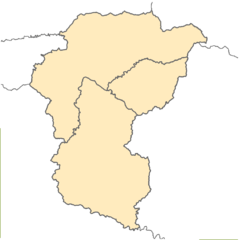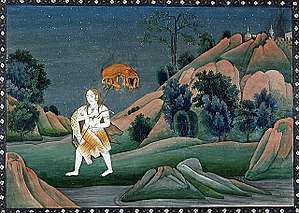Guhyeshwari Temple
| Guhyeshwari Temple | |
|---|---|
|
Main gate of Guhyeshwari Temple | |
 Location in Kathmandu | |
| Geography | |
| Coordinates | 27°42′40″N 85°21′12″E / 27.71111°N 85.35333°ECoordinates: 27°42′40″N 85°21′12″E / 27.71111°N 85.35333°E |
| Country | Nepal |
| District | Kathmandu |
| Location | Kathmandu |
| Culture | |
| Sanctum | Parvati (Guhyekali) |
| Major festivals | Navaratri, Dashain |
| Architecture | |
| Architecture | Pagoda |
| Inscriptions | Inscription of Pratap Malla, Prithivinarayan Shah |
Guhyeshwari Temple (Nepali: गुह्येश्वरी मन्दिर), also spelled Guheswari or Guhjeshwari, is one of the revered holy temples in Kathmandu, Nepal. This temple is dedicated to Adi Shakti. The temple is also a Shakti Peetha near to the Pashupatinath Temple. It is said that this temple is the Shakti chair of Pashupatinath Temple. King Pratap Malla built this temple in the 17th century. The goddess is also called Guhyekali. It is the main temple, dedicated to Guhyeshwari. It is an important pilgrimage destination for general Hindu and especially for Tantric worshipers.
The temple name originates from the Sanskrit words Guhya (Secret) and Ishwari (Goddess). In Lalitha Sahasranama the 707th name of Goddess is mentioned as Guhyarupini (The form of Goddess is beyond human perception and it is secret. Another argument is that it is the secret 16th syllable of the Shodashi Mantra) (LS 137th verse: Sarasvati shastramayi| Guhaamba guhyaruupini||).[1] It is believed that Sati Devi's corpse's parts fell in different region when Shiva took it and roamed around the world in sorrow. The Temple of Guhyeshwari lies about 1 km east of Pashupatinath Temple and is located near the banks of the Bagmati River.[2]
The main stotras dedicated to goddess are:
- Guhya Kali Sahasranama Stotra,
- Guhyakali Gadya Sanjeevana Stotram
- Guhyakali Mahavajra Kavacha Stotram
The Temple as a Shakti Peeth

The mythology of Daksha yaga and Sati's self immolation had immense significance in shaping the ancient Sanskrit literature and even had impact on the culture of India. It led to the development of the concept of Shakti Peethas and there by strengthening Shaktism. Enormous mythological stories in puranas took the Daksha yaga as the reason for its origin.The Guhyeshwari temple, dedicated to Sati Devi, Shiva's first wife, was built by King Pratap Malla in the 17th century and is considered to be one of the sacred sites of Hinduism. When Shiva was insulted by his father in law, Sati Devi was so angry that she jumped into flames of yagya ( fire worship), an event which gave rise to the practice of Sati, or self-immolation. Shiva was grief-stricken and picked up her corpse and began to wander about as her body parts fell to the earth. The temple marks the spot where her knowledge fell; guhya means secret knowledge and ishwari means goddess. The goddess is worshipped at the centre of the temple in a kalasha (water jar) that is covered with a layer of silver and gold. The temple stands at the centre of a courtyard and is topped with four gilded snakes that support the finial roof. It is often mistaken fact for taking meaning of guhya as vagina. The genitals of Sati Devi fell on the another Shakti Peeth worshipped by the name "Kamarupa-Kamakhya" in Assam. Shakti Peethas are shrines or divine places of the Mother Goddess. These are places that are believes to have enshrined with the presence of Shakti due to the falling of body parts of the corpse of Sati Devi, when Lord Shiva carried it and wandered throughout Aryavartha in sorrow. There are 51 Shakti Peethas corresponding to the 51 letters of the Sanskrit alphabet. Each temple possesses shrines for Shakti and Kalabhairava. The Shakti is Mahashira and the Bhairava is Kapali. This temple is revered by Tantric practitioners and Tantric rites are performed in this temple. The temple is also mentioned in the Kali tantra, Chandi tantra, Shiva tantra Rahasya as one of the most important places for gaining the power of tantra. The Vishwasorup of goddess Guhyeshwari shows her as a many and different coloured headed goddess with innumerable hands. The temple gets much crowded during Dashain and Navaratri.
Vajrayana Buddhism
Newar Vajrayana Buddhists consider Guhyeshwari to be sacred to Vajrayogini in the form of Vajravarahi and to be the location of root of the mythical lotus upon which Swayambhunath stupa rests, which is also the umbilical cord which nurtures Kathmandu. In Tibetan the place is called Pakmo Ngülchu (Varahi's womb fluid) and the water which flows from the spring in the well in the temple is believed to be the sexual fluid of Vajravarahi.[4]
References
- ↑ "Shakti Sadhana Org: : LalithA SahasranAma". shaktisadhana.50megs.com. Retrieved 2014-01-25.
- ↑ "Kathmandu page 4". virtualtraveling.endesign.nl. Retrieved 2014-01-25.
- ↑ "Kottiyoor Devaswam Temple Administration Portal". kottiyoordevaswom.com/. Kottiyoor Devaswam. Retrieved 20 July 2013.
- ↑ Dowman, Keith (2007). A Buddhist Guide to the Power Places of the Kathmandu Valley. Kathmandu: Vajra Publications. pp. 59–60. ISBN 978-9937-506-02-1.

